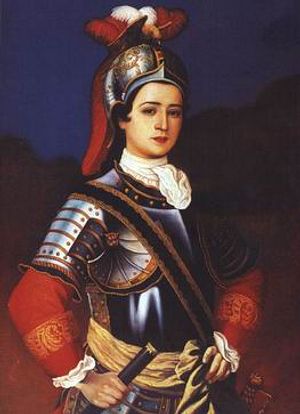China has been struggling to contain tensions in its restive northwestern region of Xinjiang, especially over the summer. However, in a new initiative, Chinese government authorities will use a cartoon to promote harmony between ethnic Uyghurs, the native Muslim ethnic group of Xinjiang, and Han Chinese.
The cartoon is to be entitled “Princess Fragrant” and will air on television as a series at the end of 2015. The cartoon is based on Ipal Khan, also known as the Fragrant Concubine, from the city of Kashgar in far western Xinjiang. She allegedly caught the attention of the Qianlong Emperor in the mid-18th century with her beauty and sweet scent (thus her nickname) after being gifted to him. He wooed her for a period of time until she fell in love with him, according to Chinese variations of stories about her. These stories maintain that he even built a replica of a desert village for her to make her feel at home. As a result, she has come to represent a symbol of ethnic unity for the Chinese people, at least the Han.
The Uyghurs tell darker tales, however. Many argue that she was stolen from her husband by invading Chinese armies. Upon being taken to Beijing, she refused to sleep with the Emperor and plotted to kill him, despite his passionate advances. Ultimately, she was killed by the Dowager Empress due to her threats.
Perhaps there is some truth in both stories. During Ipal Khan’s life, what is today Xinjiang had in fact just been conquered by the Qing Dynasty, almost accidently. The region, which centered on the Taklimakan Desert, was historically known as the Tarim Basin and featured many mercantile desert kingdoms independent of but often tributary to Chinese dynasties. During the Qianlong Emperor’s reign, the Qing Empire fought and defeated the Dzungars in an almost genocidal fashion; the Dzungars were a Mongol tribal confederacy that ruled much of the steppes and threatened the Qing. The Dzungars had previously become the overlords of the Uyghur Muslim oasis city states of the Tarim Basin. It was during these wars that the Qing conquered Xinjiang in the 1750s in order to outflank the Dzungar and deprive them of supplies. Subsequently, Xinjiang was ruled through a military garrison before becoming the province of Xinjiang in 1884 after several revolts.
Although the Chinese ruled the region fairly loosely, they also responded to military threats very forcefully. It was not uncommon for prisoners of war to be taken to China proper to serve as concubines and eunuchs. On the other hand, it was also not uncommon for locals to make their accommodations with the Chinese and integrate into the Chinese political system. Therefore, nobody can know for sure what really happened with the “Fragrant Concubine” in the 18th century. In any event, the cartoon will sidestep these issues by depicting fictional episodes from Ipal Khan’s childhood.
In any case, the cartoon may have some value in fulfilling entertainment or historical needs. Xinjiang is generally not featured widely in Chinese media and the cartoon would be a good opportunity to raise awareness of and promote Xinjiang’s culture. However, according to Chinese sources, the cartoon must also serve “political needs.” This fact along with the Uyghur variation of the story limits its appeals to Uyghurs. Rather than being historically accurate, it can be benignly interpreted as a work of historical fiction that could potentially teach a valuable moral lesson in tolerance and coexistence (the Chinese view). On the other hand, interpreted in another manner, it can be seen as a work of propaganda that distorts history (from a Uyghur perspective). In the end, while the show might build a few bridges, it will do little to solve the underlying problems that give rise to tensions in Xinjiang in the first place.

































